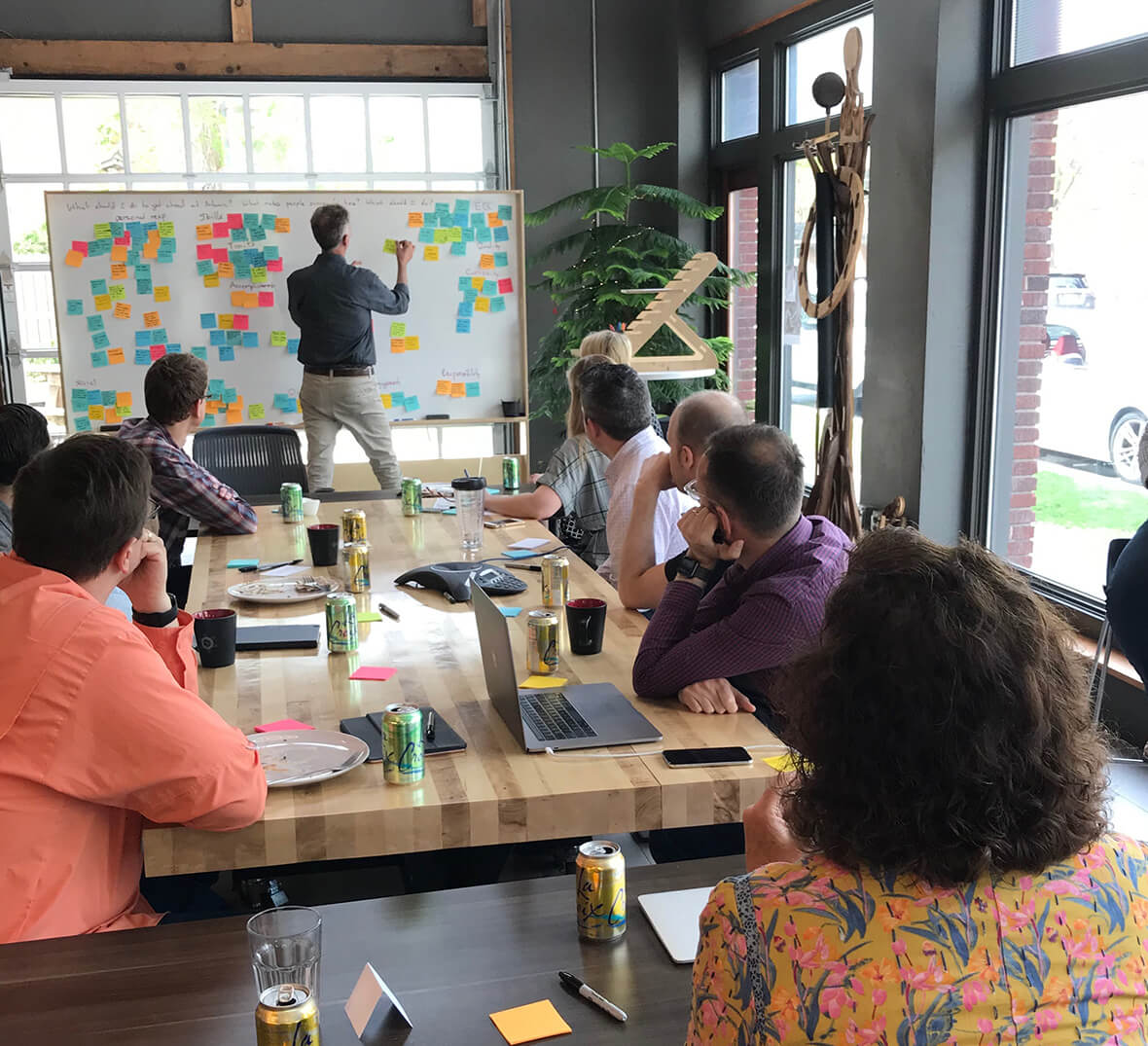We’ve all been there—meetings that go on and on, people talking in circles, arguing the same things, and wrapping up without well-defined next steps. It’s frustrating and a waste of time.
There are a few best practices that can help counteract these pitfalls (e.g. sharing an agenda with topics and time slots), but those aren’t enough.
Games Are Games Because They Have Rules
If you are a regular reader of Spin, and you should be, you’ll have seen us talk about Innovation Games over and over. It is one of the most effective resources we use when planning meetings. Kim Wolting is writing an amazing series on a Design Thinking Toolkit that highlight many of the activities and games covered in the book, and how to properly facilitate them.
The best part about games, and why they are so effective, is that they have rules! Rules make everything better. As a society, we love rules. Imagine playing any game without rules.
No seriously, take a minute, close your eyes and visualize a game of hockey without rules. It would be pure chaos. All of a sudden, a team has more players than the other. How about the goalie just building a brick wall in front of his goal. Or even a player grabbing the keys to the Zamboni and running other players off the ice.
It takes rules, boundaries, and structure for the game of hockey to exist. The same should apply to meetings.
Meetings without Games
Meetings without games are like sports without rules. They become a total free-for-all, and at the end, there’s no winner.
When a meeting is unstructured, topics become muddied, full of tangents, and it usually becomes a conversation between the two most vocal people in the room while the rest of the participants become a passive audience.
In addition, company hierarchy becomes awkwardly transparent, office politics begin to play a role, and different people are often saying the same thing, without even realizing it.
Meetings with Games
However, meetings with games are incredibly productive. Why? Games are a great way to encourage (read force) participation from everyone in the room. Understandably, some people are more outgoing than others and feel more comfortable speaking up during meetings. But when everyone is given instructions on how to formulate their ideas, and equal time and priority to present, it reduces anxiety.
When everyone is given equal time to participate in games, it really starts to blur the lines of company hierarchy. Surprisingly, CEO’s don’t know everything. Giving a salesperson the same tools to communicate an idea as their manager can be enlightening. And vice versa, having a manager speaking with a subordinate at the same level, within the same rules, allows for a better shared understanding of goals and motivations.

Okay, But How?
Let me start with a recent example from Atomic. Just last week, our Advisory Board met for a 1-hour meeting. The main topic: What advice would you give to a new Atom on how to be successful working here? This could have been an open discussion, with people telling long-winded anecdotes, and other’s piggyback off of topics until the meeting was over.
Instead, we all played a game. Everyone took sticky notes and sharpies, and for about 10-15 minutes or so, we each wrote down quick snippets of advice and stuck them on the whiteboard. I think everyone used about 10-15 stickies. Then we read each and every note and started affinity mapping them into themes. We started to see trends around personal responsibility, emotional intelligence, social involvement, and skills/traits. Afterward, we had an open discussion based on what we found interesting in the exercise.
It was a successful meeting. Why? We had defined rules for an activity, everyone was involved in an equal capacity, we avoided tangents, and we quickly moved from one part of the activity to another. Also, at the end of the day, we had an artifact that was more representative of our meetings takeaways than just some “notes”.

Tips for Incorporating Games
- Have an agenda, and plan out each game carefully.
- Try to have information from one game directly translate into the next game (i.e. developing user personas is a great precursor to working through context scenarios).
- Tell everyone know how the game works (expectations, rules, etc.).
- Have an appropriate time allotted, and stick to it as best you can.
- Appoint one person to lead the activity. Appoint another person to be the rule keeper, watch the time, and nip tangents in the bud.
- Last, but most importantly, force everyone to participate!
A Day Full of Games
When we kick off new projects, we often start with a day full of games. Here’s what a common kickoff meeting agenda might look like.
9:00a – Introductions and Agenda Overview
Quickly go around the room, and everyone has to introduce themselves. It’s a great icebreaker to get people started talking right away. Then, review the agenda. Let people know that the day will be full of games and activities, and participation is preferred (required!).
9:10a – Personas & Context Scenarios
Prepare a few big sheets of butcher paper with a basic User Persona template. Give the user a name, and job title, and then invite everyone to write their goals and motivations on sticky notes, and then place on sheet. Jason Porritt wrote a great post on how to develop user personas.
We combined Context Scenarios with our users as well. Start Your Day provides a great structure to really focus people on defining activities that a user would do at specific times of the day, week, or year.
10:30a – Break
It is important to incorporate breaks into the day. Phones and computers should not be allowed in the room, but allow people the opportunity to check their emails and messages.
10:45a – Business Ecosystem Map
I’m going to plug my own post here on the importance of defining an Ecosystem Map. Check it out.
12:00p – Lunch
Got to have that brain food. It’s recommended to have food brought in if at all possible. This limits a lot of time wasted for traveling to get food. If you have to go out, go as a group. This is an important time to have casual conversation.
1:00p – Focus, Delegate
For this particular project, we were working on rewriting a piece of software they were using to run their business. On sticky notes (so many stickies!), we captured all of the functionality the current system was responsible for.
We then drew three columns on a white board, and put all of the stickies under the first category: Now. Then, we took each sticky, read it aloud, and asked the group to determine whether the rewritten software should focus on this functionality, if we could delegate a more appropriate application to handle it, or if it could be removed entirely.
Focusing on one sticky at a time kept the group focused. If no consensus was made within a couple of minutes, we moved on to another sticky, and came back to the original one later.
2:30p – Remember the Future
Through effective game playing during meetings, so many more ideas are going to be generated than a traditional meeting. It was important to wrap up the day with everyone’s thoughts on what success looked like to them. Capture it while it’s fresh. Kim wrote another great toolkit post on facilitating Remembering the Future.
3:30p – Day Complete
All day doesn’t mean all day. These games are tiring to play sometimes. There is a lot of brain power used. Let people go early, and decompress.
Stop Tangents at All Costs
Structuring meetings around games is probably a foreign concept to a lot of people, and not inherently part of their company culture. People are going to go on tangents. Outspoken people will try to interject and interrupt. Power struggles will inevitably try to formulate. But they must be stopped!
Stay on track, and force all conversations to happen within the rules of the game. Keeping everything structured allows everyone to be a part of the conversation.


Fantastic! I’m all about playing games and playing in general to improve work. I’m curious if you could talk about how you reveal the rules, enforce rules, and if the rules are specific to each game?
Hi Bridget, thanks for the questions! For larger meetings, we typically give a copy of the agenda, which has a high-level overview of all of the activities. When we get to a specific game, we explain the rules, and then demonstrate the steps using a hypothetical, yet relatable example. For instance, ‘ordering a pizza online’ to demonstrate how we could document a context scenario.
Enforcing the rules can be a bit tougher, and it’s up to the facilitator to use their best judgement. Sometimes activities don’t go exactly as planned, but as long as the group is staying on topic and uncovering great insights, don’t derail the conversation. But if tangents, and side discussions are starting, then definitely nip those in the bud!
Thanks Kyle. Enforcing the rules can be tough. I’ve seen some people ring a bell or put bandaids on people who “ouch” others or stray from the rules. However, this negative enforcement of the rules can sometimes shut people down to the idea of sharing as much as the person who “ouched” them.
I definitely try to stay away from gimmicky things like a bell, or bandaids. Making “messing up” a part of the activity becomes even more of a distraction. The important thing about tangents, though, is to not lose the idea of the conversation.
Normally, we will see a tangent or side conversation happen during our very first exercise, and that’s when we introduce participants to the “parking lot”. Our parking lot is a visible list (on a whiteboard, or butcher paper), that we write down all of the ideas that are being discussed during conversations that are derailing the conversation, with the idea that we come back around to these topics later (if they are still important/relevant at the end of the meeting).
The parking lot works really well, because it’s a respectful way to stop a conversation and document what was being talked about. When you simply interrupt what someone is saying, without calling out the significance of it, they will feel undervalued for the rest of the meeting or workshop. Someone who feels undervalued doesn’t want to participate, and activity/game based meetings only work when everyone is participating!
Thank you so much for your questions and sharing your experiences!